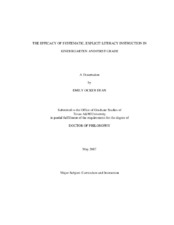| dc.description.abstract | This investigation examined the extent to which teacher implemented systematic, explicit instruction affected the literacy achievement of kindergarten and first grade students. Two cohorts of students in a southwestern United States school district were utilized for this study. Cohort 1 (n=94) received classroom literacy instruction from the state adopted basal reading series. Cohort 2 (n=96) received literacy instruction from the basal series and an additional reading program designed to systematically and explicitly teach phonological awareness, letter name identification, and the alphabetic principle. Each cohort was followed from the middle of kindergarten through the end of first grade. Kindergarten measures included the Texas Primary Reading Inventory (TPRI) tests of phonological awareness, letter naming, letter sound knowledge, and listening comprehension, and were administered at the middle and end of kindergarten. At the beginning of first grade, TPRI phonological awareness, word reading, reading comprehension, and fluency were measured. Middle of year first grade variables were TPRI reading comprehension and fluency. End of the year first grade measures were TPRI word reading, fluency, reading comprehension, and Iowa Test of Basic Skills (ITBS) word analysis, reading comprehension, listening comprehension, vocabulary, and spelling. A MANCOVA was conducted at each interval using English language learner status as the covariate. Hierarchical regression analysis was conducted to determine which variables best predicted end of first grade reading comprehension, word reading, and fluency. Results from the MANCOVA indicated that Cohort 2 outperformed Cohort 1 on kindergarten TPRI measures of phonological awareness, letter naming, and letter sound correspondences. Cohort 2 also performed better than Cohort 1 on first grade TPRI reading comprehension, fluency, and end of year word reading, however, there were no statistically significant differences on the ITBS measures. Conclusions and recommendations for further research and for practice are also discussed. | en |


